Remembering distinguished Jamaicans – Allan Coombs
On Labour Day, Jamaicans should be focusing on workers’ struggles for decent working conditions, liveable wages, and their other rights, especially recalling the 1938 labour uprisings from which came the formation of trade unions, political parties, and the movement towards Independence.
The period leading up to 1938 was very difficult economically with the First World War; a pandemic, the ‘Spanish’ Flu; the Wall Street crash; and the 1930s Great Depression. Like today, Jamaica then depended on international trade, and what happened in the international community affected the country. So it is not surprising that the 1938 uprisings were on the ports and sugar estates. It should not be surprising that today, the COVID-19 pandemic, economic recession, war in Ukraine, and high inflation are seeing workers getting agitated.
The 1930s labour unrest saw some very colourful and assertive characters rise to leadership positions in the trade union movement and in politics. These included Alexander Bustamante, St William Grant, and Allan George St Claver Coombs. Much has been written about these men. This week, nevertheless, I will remain with Norman Manley’s Cabinet of 1955 and 1959 and say a few words about a man who was described as “extremely colourful and pugnacious”. He seems to have been a controversial character. This was Allan George St Claver Coombs or A.G.S. Coombs, also known as Father Coombs.
BORN IN ST ANN
A.G.S. Coombs, according to various publications, was born in Salisbury, St Ann, on August 16, 1901. His father may have been a Joseph Coombs. There is not much about his parents and early life. He attended elementary schools. He was a member of the Jamaica Constabulary Force and the West India Regiment. He later joined the Public Works Department in 1934. Coombs was a pupil of life experiences from which came his interest in workers’ rights and his activism. He organised the first trade unions in 1936. He was a founding member of the Bustamante Industrial Trade Union with St William Grant and Bustamante in 1938. He joined the People’s National Party (PNP) with Norman Manley in 1939 and transitioned to its trade union, the National Workers’ Union.
He was first elected to the House of Representatives, representing North Western St James in 1949. He was re-elected in 1955 and was appointed to the Cabinet as minister of communications and works. He retained his seat in the 1959 election and his Cabinet post. By the end of 1961, something had gone wrong in his relationship with N.W. Manley, the premier, and their party. According to The Gleaner, Coombs was relieved of his Cabinet position. He clearly left the PNP and ran as an independent candidate in the April 1962 General Election. He placed third to the Jamaica Labour Party and PNP candidates. Thereafter, he faded from the political scene.
Coombs married twice. First to Ida May Simpson on March 9, 1948. They divorced in 1957. On December 4, 1958, he married Beryl Stewart.
His death, on July 15, 1969, was reported in The Gleaner. There is no doubt that A.G.S. Coombs, despite whatever happened at the end of his political career, was a champion of workers’ rights and one of the most interesting characters of the period 1938-1962. It was reported that his body was exhumed and reburied in Manchester in 2013, by family, as it was felt that he had not been accorded the burial he deserved. There was an inaugural, A.G.S. Coombs lecture at UWI, Montego Bay Campus, in 2013.
This is another politician of the era who would benefit from further in-depth study. Sometimes, in research, what one finds is not what was expected.
- Contributed by Marcia Thomas


